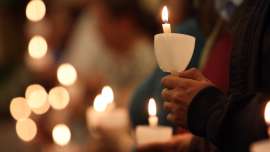
Fire of Love
There are two places in Scripture where the curious detail of a “charcoal fire” is mentioned.
One is in today’s Gospel, where the Apostles return from fishing to find bread and fish warming on the fire. The other is in the scene in the High Priest’s courtyard on Holy Thursday, where Peter and some guards and slaves warm themselves while Jesus is being interrogated inside (see John 18:18).
At the first fire, Peter denied knowing Jesus three times, as Jesus had predicted (see John 13:38; 18:15-18, 25-27).
Today’s charcoal fire becomes the scene of Peter’s repentance, as three times Jesus asks him to make a profession of love. Jesus’ thrice repeated command “feed My sheep” shows that Peter is being appointed as the shepherd of the Lord’s entire flock, the head of His Church (see also Luke 22:32).
Jesus’ question: “Do you love me more than these?” is a pointed reminder of Peter’s pledge to lay down his life for Jesus, even if the other Apostles might weaken (see John 13:37; Matthew 26:33; Luke 22:33).
Jesus then explains just what Peter’s love and leadership will require, foretelling Peter’s death by crucifixion (“you will stretch out your hands”).
Before His own death, Jesus had warned the Apostles that they would be hated as He was hated, that they would suffer as He suffered (see Matthew 10:16-19,22; John 15:18-20; 16:2).
We see the beginnings of that persecution in today’s First Reading. Flogged as Jesus was, the Apostles nonetheless leave “rejoicing that they have been found worthy to suffer.”
Their joy is based on their faith that God will change their “mourning into dancing,” as we sing in today’s Psalm. By their sufferings, the know, they will be counted worthy to stand in heaven before “the Lamb that was slain,” a scene glimpsed in today’s Second Reading (see also Revelation 6:9-11).
Pope Benedict XVI
from Homily, “Orti Borromaici” Esplanade, Pavia, April 22, 2007
During the Easter Season, the Church presents to us, Sunday after Sunday, some passages from the preaching with which, after Easter, the Apostles, particularly Peter, invited Israel to have faith in Jesus Christ, the Risen One, thereby founding the Church.
In today’s reading, the Apostles stand before the Sanhedrin – before that institution which, having sentenced Jesus to death, could not tolerate that this same Jesus was now beginning to be active again through the Apostles’ preaching. They could not tolerate that his saving power was once more making itself felt and that his Name was attracting people who believed in him as the promised Redeemer.
They accused the Apostles. Their accusation is: “You want to make us responsible for that man’s blood”.
Peter, however, reacted to this accusation with a brief catechesis on the essence of Christian faith: “No, we do not want to make you responsible for his blood. The effect of the death and Resurrection of Jesus is quite different. God has exalted him as “Head and Saviour’ of all, and of you, too, his People of Israel”. And where will this “Head” lead us? What does this “Saviour” bring?
He leads us, St Peter tells us, to conversion – creates for us the leeway and opportunity to mend our ways and repent, begin again. And he offers us forgiveness for our sins: he introduces us into the proper relationship with God, hence, into the proper relationship of each individual with himself or herself and with others.
Peter’s brief catechesis did not only apply to the Sanhedrin. It speaks to us all, for Jesus, the Risen One, is also alive today. And for all generations, for all men and women, he is the “Head” who shows us the way and the “Saviour” who straightens out our lives.
The two terms: “conversion” and “forgiveness of sins”, which correspond to the titles of Christ “Head”, archegòs in Greek, and “Saviour”, are the key words of Peter’s catechesis, words intended to move our hearts too, here and now. And what do they mean?
The path we must take – the path that Jesus points out to us – is called “conversion”. But what is it? What must we do? In every life conversion has its own form, because every human being is something new and no one is merely a copy of another.
But in the course of history, the Lord has sent us models of conversion to whom we can look to find guidance. We could thus look at Peter himself to whom the Lord said at the Last Supper: “[W]hen you have turned again, strengthen your brethren” (Lk 22: 32).
